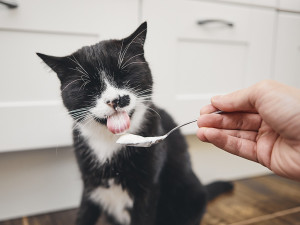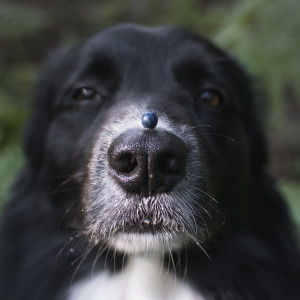Some Like It Hot — The Benefits of Warming vs. Cooling Diets
Here’s how certain foods can balance your pet’s energy and even ease their allergies, according to Chinese medicine.

share article
It feels like a long-standing tradition at this point, but nutritional labels have only been required in the U.S. for 28 years. Before 1994opens in a new tab, the number of calories in a single can of soup weren’t always glaring at us. Over the past few decades, we might have gotten used to scanning the labels as we stroll down the market aisles, but not everyone values food like this.
In traditional Chinese medicine, food is evaluated opens in a new tabbeyond the number of calories, fat, or sodium it contains; it’s measured for its energetic properties and what those properties bring to the person or animal who consumes it. Some foods have warm energy and can have a warming impact on the body. Others have cooling energy and cooling properties. Some foods have neutral properties. Knowing which foods are warming and cooling can help a person balance the overall energy — or chi — that flows within them.
But we’re not here to talk about people. So, to understand how all of this applies to pets, The Wildest consulted integrative veterinarian Dr. Lindsey Wendtopens in a new tab.
Energy Imbalances
Chi is the life force that runs through all living beings, and imbalances in it can affect the body, mind, and spirit. If we can identify these excesses or deficiencies in our pets, we can take corrective measures to bring that energy into balance. The key is to know what to look for.
“If a pet has a chi deficiency, there would be some signs that they are unwell,” Dr. Wendt tells The Wildest. “Energy imbalances can present in different ways depending on the organ affected. For example, a heart chi deficiency can result in heart failure. In other words, the heart is not pumping efficiently, so blood backs up and causes fluid to fill the lungs. A spleen chi deficiency would manifest as diarrheaopens in a new tab, vomitingopens in a new tab, decreased appetiteopens in a new tab — but also lower energy in general and [lead to] muscle mass loss.”
Knowing what’s normal for your pet is essential when assessing energy imbalances so you have a baseline. But you also have to consider that some animals are born with a deficiency.
“Jing is the energy that allows organs to form appropriately and for animals to be in good health when they come into the world,” Dr. Wendt says. “In Chinese medicine, any pet born with a congenital issue has a jing deficiency. So while it’s important to know what’s normal for your pet, that ‘normal’ may not mean that they are in balance.”
Warming and Cooling Foods
As humans, we intuitively gravitate toward certain foods based on their warming or cooling properties. That’s why we reach for a slice of watermelon (a cooling food) on a hot summer day. But in the middle of winter, we lean toward hot foods like lamb or venison. Although these choices come naturally to us in the moment, there are also ways to use them intentionally. In the case of energy imbalances, the food we feed our pets can be medicine. Dr. Wendt explains.
She adds that “if an energy imbalance is causing too much heat in the body, feeding cooling foods can put water on that fire and dampen it.” Skin inflammation, intestinal inflammation, and bladder inflammation or infection, for example, can be solved by feeding cooling diets.
"If a dog has digestive issues and food is not moving through the intestinal tract fast enough, sometimes that can be from a lack of heat to get it to move,” she says. “So, you wouldn’t want to feed a really cold diet to a pet with digestive issues. Instead, Chinese medicine recommends feeding a diet of gently cooked, warm foods. That’s because they’re already partially digested, so the pet’s body has to impart less energy to break it down.”
Let’s look at another practical example. Because allergiesopens in a new tab (a hot condition!) are a common concern in dogs and cats, Dr. Wendt shares a few guidelines for pet parents looking for the best food options.
Cooling and neutral foods that are good choices for pets suffering from allergies include:
Fish oilopens in a new tab (as long as your pet doesn’t have a sensitivity to fat)
Most fish
Beef
Rabbit
Barley
Millet
Potatoes and sweet potatoesopens in a new tab
Quinoa
Good cooling treats for an allergy sufferer are:
Celery
Zucchini
Mango
The following warm or hot foods are better to avoid:
Lamb
Venison
Shrimp
Chicken opens in a new tab(in part, because it’s also a common food allergy)
Oats
The tricky part is that most commercial pet foods combine warming and cooling ingredients, though many skew warm. But you can also experiment with supplementing your pet’s diet with fresh foods. Dr. Wendt has a few tips for incorporating these foods.
“If you’re playing around with fresh foods, introduce small amounts of one thing at a time, so you know if your pet has a sensitivity to it. I recommend adding one new item every five to seven days,” she says. “That way, you can monitor for increased itchiness, vomiting, stool changes, and appetite changes. Keep a list so you can refer back to it. Once you test everything, you can start combining foods.”
Partnering With a Veterinarian
Having a good relationshipopens in a new tab with a veterinarian who can help you explore using warming or cooling foods to balance your pet’s energy is important. Unsurprisingly, good energetics and traditional Chinese medicine are not taught in Western veterinary schools. While there are sources for veterinarians to learn this information, you’ll likely encounter many vets who are unfamiliar with diagnosing and treating energy imbalances. In these instances, you can seek out other means of support.
“If an understanding of these concepts is not in your vet’s knowledge base, ask if they work with or know of any veterinarians that have this experience,” Dr. Wendt advises. “You can also check the American Holistic Veterinary Medical Associationopens in a new tab website, which has a directory of doctors that practice holistic medicine. And some integrative vets do tele-consulting, if you can’t find one in your local area.”
Another resource to check is the American College of Veterinary Nutritionopens in a new tab’s directory. These specialists have a better perspective in general about nutrition than a general practician. No matter who you choose, it’s important to maintain an open dialog with your veterinarian and always do your best to advocate for your pet.
Disclaimer alert: This article is here to share information. But, much like pineapple on pizza, the topic may be controversial. Meaning, not all vets or pet professionals agree. Because every pet is a unique weirdo with specific needs. So, don’t take this as fact or medical advice. Talk things over with your vet when making decisions, and use your best judgment (about both your pet’s health and pizza toppings).

Kate Sheofsky
Kate Sheofsky hails from San Francisco, where she developed a love of writing, Giants baseball, and houses she can’t afford. She currently lives in Portland, OR, and works as a freelance writer and content strategist. When not typing away on her laptop, she enjoys tooling around the city with her two rescue pups searching for tasty food and sunny patios.
Related articles
![A dog scratching itself among the leaves outside.]() opens in a new tab
opens in a new tabImmunotherapy Can Be the Solve For Your Dog’s Allergies
If allergens were to ask, “Am I the drama?,” the answer would be yes.
![A dog sniffing a mushroom out of a hand.]() opens in a new tab
opens in a new tab6 Mushroom Superfoods that Won’t Turn Your Dog Into a Zombie
Nothing to fear here The Last of Us fans — ’shrooms are great immune-boosters.
![A dog eating food out of a dog bowl labeled "Bark"]() opens in a new tab
opens in a new tabBARK’s Breed-Specific Food Adds Extra Pampering to Your Dog’s Life
Pampered pooch? You wouldn’t have it any other way.
- opens in a new tab
Are GMO Foods Safe For Your Dog?
Holistic vet Robert Silver breaks it down.
![brown puppy eating food out of green bowl]() opens in a new tab
opens in a new tabA Digestible Guide to Healthy Dog Food
How to pick the right grub for your pup when there are So. Many. Choices.









